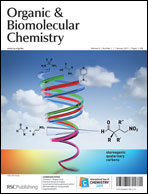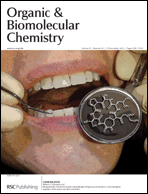Nicholas H. Evans and Paul D. Beer at University of Oxford, describe in this paper the first example of a solution based redox-active interlocked host system capable of the electrochemical recognition of anions and most specifically chloride.
Read this HOT article, as rated by the referees, which will be free to access until 6th December.
A ferrocene functionalized rotaxane host system capable of the electrochemical recognition of chloride
Nicholas H. Evans and Paul D. Beer
Org. Biomol. Chem., 2011, 9, 92-100
DOI: 10.1039/C0OB00458H











 Thomas Nugent and colleagues at Jacobs University describe the use of a three component catalyst, an amino acid, a base and a hydrogen bond donor, to form quaternary C-C bonds in this paper that is the front cover of
Thomas Nugent and colleagues at Jacobs University describe the use of a three component catalyst, an amino acid, a base and a hydrogen bond donor, to form quaternary C-C bonds in this paper that is the front cover of  The very successful OBC Communication by Robert H. Cichewicz and coworkers, at the University of Oklahoma, on mutanobactin A and its influence on the yeast-mycelium transition of Candida albicans is now the inside cover of Issue 24.
The very successful OBC Communication by Robert H. Cichewicz and coworkers, at the University of Oklahoma, on mutanobactin A and its influence on the yeast-mycelium transition of Candida albicans is now the inside cover of Issue 24. Rajeev Menon and Martin Banwell at the Australian National University in Camberra have identified a novel and highly efficient Au (I) catalysed intramolecular Michael addition reaction that is a key step towards the first total synthesis of crassifolone and dihydrocrassifolone.
Rajeev Menon and Martin Banwell at the Australian National University in Camberra have identified a novel and highly efficient Au (I) catalysed intramolecular Michael addition reaction that is a key step towards the first total synthesis of crassifolone and dihydrocrassifolone.